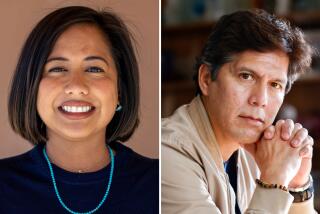Navajos Try to Seize Power in Sweeping Bid for Office : Politics: An All-Indian slate runs in county election in southern Utah, with the goal of redistributing funds.
- Share via
MONTICELLO, Utah — Until the day this spring when six American Indians walked into the San Juan County Courthouse, the Navajos of southern Utah had offered little resistance to the steady encroachment of white settlers into the starkly beautiful canyons along the San Juan River.
Soon after the first Mormon wagons arrived in 1880, the Navajos were confined to the barren lands of a reservation. They languished in poverty while the Mormon settlers built prosperous towns and established farms of wheat and alfalfa.
Now, the Navajos believe they can turn the established order upside down. Their goal is to take over the “white man’s government” in the next countywide elections and radically redistribute county funds.
The movement is apparently the first attempt by American Indians to use the ballot box to unseat an established, Anglo-dominated government. A Navajo victory could send an important signal across the West, where American Indians form large but often inactive voting blocs in dozens of rural counties.
The six who entered the courthouse registered to run as an All-Indian slate for key posts inthis county of 13,000 residents, which is split almost evenly between Indians and whites.
Mark Maryboy, 34, a tall, soft-spoken Navajo who is running for reelection to the county commission, heads the slate. The Indians, all Democrats, face an all-white, all Republican slate of incumbents, some of them descendants of the Mormon pioneers of the last century.
Supporters of the Indian candidates wear T-shirts proclaiming in Navajo: “Niha whol zhiizh” (It’s our turn).
“I don’t see why Native Americans should suffer if they can see the problems are all around them,” Maryboy said. “They should speak out and fight for their rights.”
Perhaps inevitably, the campaign has turned ugly.
Two Indian candidates say they were insulted by angry whites while marching in a Fourth of July parade in the predominantly white town of Blanding.
Both sides have exchanged allegations of corruption and racism in recent weeks. This month, federal mediators arrived in the county to help soothe the growing ethnic tensions.
“I think (the Mormons) have the attitude that they’re somehow chosen by God to be superior to anybody who isn’t a member of the church,” Maryboy said. “We shouldn’t be afraid of the white people. They eat, breathe and die like we do.”
Most Anglo residents seem angered by the Navajos’ move for power. Some believe an Indian-led government would lead to fiscal disaster. More than anything, the Anglo farmers, schoolteachers and merchants say they resent that race and religion have even become issues in their otherwise peaceful, bucolic county.
“If there’s racism and prejudice, it sure as heck isn’t coming from me,” said Tyrone Lewis, 47, a Mormon farmer and county commissioner who has tangled with Maryboy and other Indian leaders. “If (the Navajo candidates) don’t get their way, they start screaming racism. . . . I’m not a racist. Some of my best friends are Navajos.”
Nor is their unity in the Navajo ranks. Some conservative Navajos have reportedly summoned “skinwalkers,” Indian shamans, to launch a spiritual war against their radical brethren.
Undaunted, the members of the Indian slate and their supporters have forged ahead with the election drive. They have set a goal of registering 2,000 new Navajo voters. Presently, the county has 6,000 registered voters, most of whom are white.
But organizing a mass movement among the Navajos hasn’t been easy, said Jean Melton, 37, the slate’s campaign manager. For one thing, many of the registration applications get turned down by the county because of the difficulties in establishing correct names and addresses on the reservation.
In addition, Navajos traditionally have found strength in an ancient belief system that stresses obedience to the tribe alone.
The Navajo language itself is a problem, Melton said, since English political terms and slogans have few Navajo equivalents.
“There’s no way to say ‘Power to the people’ in Navajo,” she explained. Power can only go to the niha , the leader. You have to use metaphors. We tell a story about driving a car. About how you have to drive a car yourself and how no one can do it for you.”
For years, the Navajos have virtually ignored the white man’s affairs, Melton said, and many consider San Juan County to be literally a foreign government, a world apart from their sovereign Navajo nation.
Ruby Nakai, this year’s Indian candidate for county clerk, said until recently she mistakenly thought it was illegal for residents of the reservation to run for county office.
“It was always people from off reservation who were running, so it made me think we weren’t eligible,” said Nakai, 41, a Cherokee who married into a Utah Navajo family. “We need to educate everybody that we’re all citizens of this county.”
If Navajos can win a stronger voice in county government, Nakai and the other Indian candidates argue, residents of the reservation can finally get their fair share of badly needed services, including electricity and water.
San Juan is both Utah’s poorest and largest county. About 30% of county families live below the poverty level.
More than 75% of the families on the arid, desert-like reservation do without running water. Many Indian communities in the 7,800-square-mile county--roughly the size of Connecticut--are not served by roads and can only be reached on horseback.
Ironically, the impoverished Utah Indians live on top of a large oil and natural gas field that generates millions of dollars of royalties for state, county and tribal governments.
One recent study found that between 1979 and 1988, the reservation had generated more than $50.6 million in revenues for the county, but had received in return only $30.5 million in services.
Even if the All-Indian slate doesn’t sweep the November election, Daniel McCool, a political scientist at the University of Utah, said he believes it is only a matter of time before the Navajos exert political dominance in San Juan County.
In the long run, demographic trends and increased political awareness among American Indians favor the Navajos, he said. Similar patterns have led to recent victories by individual Native American candidates in county elections in New Mexico, Arizona and Montana.
“You’re really talking about the potential takeover of the San Juan County government--ultimately that’s going to happen,” he said. “It’s going to be a very confrontational process, but eventually (Navajos and Anglos) will learn to work together. They will learn that confrontational politics have a tremendous price.”
For now, however, the Anglo residents of San Juan County don’t seem to be willing to surrender the county government they have controlled for more than a century.
At the Blanding auto parts store of Howard Randall, where a half dozen residents angrily discussed campaign developments, Kelly Laws, a 35-year-old farmer, said Navajos don’t deserve to hold county office because, as residents of the sovereign Navajo reservation, they don’t pay local property taxes.
“We had a civil war once because we had a nation within a nation,” said Laws, whose grandparents worked as Mormon missionaries on the Navajo reservation. “It looks crooked to me to have someone getting a job that’s paid by the taxpayers and not having to pay taxes yourself.”
Laws and other Anglo inhabitants of the county say they find the Navajo challenge especially difficult to accept because they take pride in the efficiency and independence of their local government.
Blanding, Monticello and other towns in San Juan County were created by hardy Mormon pioneers whose religious faith helped them overcome both the unforgiving desert terrain and the persecution of federal marshals, who sought to arrest them as polygamists.
Given this history, it didn’t sit too well with most Mormon residents here when federal officials arrived in the county earlier this year to monitor the election and to ensure compliance with voting rights laws.
U.S. attorneys had filed suit against the county in 1984, alleging that the county had failed to guarantee fair elections and full participation among Navajo-speaking voters. The suit was settled when the county agreed to redraw district boundaries so that an American Indian could be elected to the three-member county commission.
But U.S. attorneys have made new requests of county officials, including that they produce Navajo-language radio commercials announcing the election, said County Clerk Gail D. Johnson.
Johnson said that even though she has worked hard to comply with the requests, she still resents the intervention of the federal authorities.
“When you complain, it looks like you’re racist against the Navajo,” she said. “But it’s not that at all. It’s the principle of the thing. I think that’s oppressive in America, for the federal government to come in and do that to a little local government.”
Whatever the outcome of the November election, supporters of the All-Indian slate say they can already claim an important victory--more Navajos than ever are registered to vote and there is a growing consciousness among them about the importance of local government.
That much was clear late one afternoon, when 25 Navajos gathered to discuss the election at the home of a supporter in the heart of the Indian reservation.
To escape the heat on the sagebrush covered mesa, the meeting was held in the shade of a “summer house,” a shack with a makeshift roof of roughly cut wooden beams and cottonwood branches.
“How many here will register people to vote?,” Chester Harrison, a social worker, asked in Navajo. There was a brief pause.
“It only takes 10 minutes,” he added. “Remember, we’re all climbing this mountain together.”
Finally, most of those present raised their hands.
Although power lines to the oil and gas fields of the reservation run close by, the home was without electricity. When the sun set and the desert sky turned to deep violet, the activists found themselves sitting in the dark.
Rather than call an end to the meeting, two men walked across a dirt path to their automobiles. They used the car headlights to illuminate the gathering.
And the talk of ballots and election campaigns continued.
More to Read
Sign up for Essential California
The most important California stories and recommendations in your inbox every morning.
You may occasionally receive promotional content from the Los Angeles Times.











